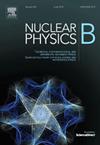Ray and wave optics in Bonnor-Melvin domain walls: Photon rings
IF 2.5
3区 物理与天体物理
Q2 PHYSICS, PARTICLES & FIELDS
引用次数: 0
Abstract
In this study, we examine the propagation of light rays and wave dynamics within the -dimensional analogue of the Bonnor-Melvin magnetic (BMM) spacetime, which incorporates a nonzero cosmological constant. The BMM spacetime, characterized by cylindrical symmetry, maintains Lorentz invariance along the axial direction, facilitating a systematic investigation of ray trajectories and wave behavior in the corresponding -dimensional magnetic background. This three-dimensional spacetime can be derived as a -brane solution within the context of gravity coupled to nonlinear electrodynamics. Initially, we analyze general ray trajectories and derive exact solutions for the angular motion of light rays. Our findings reveal that light is confined to circular paths within a specific radial region, indicating the formation of light rings governed by the magnetic background. Extending this analysis to wave dynamics, we solve the Helmholtz equation analytically, identifying discrete wave modes with quantized frequencies. The background gravitational field induces oscillatory wave behavior, resulting in well-defined photonic states. These states are notably ring-shaped and rotate, resembling magnetic vortices.
波诺-梅尔文畴壁中的射线和波光学:光子环
在这项研究中,我们研究了(2+1)维波诺-梅尔文磁(BMM)时空模拟中的光线传播和波动动力学,其中包含了一个非零宇宙常数。BMM时空以柱面对称为特征,沿轴向保持洛伦兹不变性,有助于系统地研究相应(2+1)维磁背景下的射线轨迹和波动行为。这个三维时空可以在重力耦合到非线性电动力学的背景下导出为(2+1+0)-膜解。首先,我们分析一般的光线轨迹,并推导出光线角运动的精确解。我们的发现表明,光被限制在一个特定的径向区域内的圆形路径上,这表明了由磁背景控制的光环的形成。将此分析扩展到波动动力学,我们解析求解亥姆霍兹方程,识别具有量子化频率的离散波模。背景引力场诱导振荡波行为,产生定义良好的光子态。这些状态明显呈环状并旋转,类似于磁涡流。
本文章由计算机程序翻译,如有差异,请以英文原文为准。
求助全文
约1分钟内获得全文
求助全文
来源期刊

Nuclear Physics B
物理-物理:粒子与场物理
CiteScore
5.50
自引率
7.10%
发文量
302
审稿时长
1 months
期刊介绍:
Nuclear Physics B focuses on the domain of high energy physics, quantum field theory, statistical systems, and mathematical physics, and includes four main sections: high energy physics - phenomenology, high energy physics - theory, high energy physics - experiment, and quantum field theory, statistical systems, and mathematical physics. The emphasis is on original research papers (Frontiers Articles or Full Length Articles), but Review Articles are also welcome.
 求助内容:
求助内容: 应助结果提醒方式:
应助结果提醒方式:


